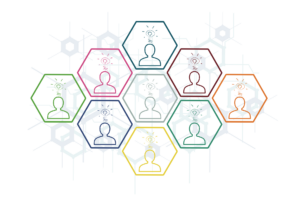Driving the Necessary Data Steps
Sisense, in the company’s blog on “5 Steps to Data-Driven Business Decisions,” makes the case that this new world of expanding data has given innovation efforts an increased pace of agility. No longer is this just the realm of the data scientist. “With technology underlying almost every aspect of your business, you can use the data it generates to see exactly what’s happening in your organization and use the information to make your business more agile by testing out different scenarios and their success,” observes Sisense.
Forward-thinking, data-driven companies ultimately can be more competitive, customer focused, cost effective, opportunistic, and become more agile. Of course, the value also comes from identifying what data to use and generating insights from it. Sisense further outlines five steps to focus an organization’s data-driven business decisions:
- Step 1: Strategy: Data-driven decision making starts with the all-important strategy. This helps focus your attention by weeding out all the data that’s not helpful for your business and your objectives.
- Step 2: Identify Key Areas: It’s essential to manage the multiple sources of data and identify which areas will bring the most benefit. Which area is key to achieving your overarching business strategy?
- Step 3: Data Targeting: Now that you’ve identified which areas of your business will benefit the most from analytics and what issues you want to address, it’s time to target which datasets will be most helpful. This involves looking at the data that you already have and finding out which data sources provide the most valuable information. This will help streamline data.
- Step 4: Collecting and Analyzing Data: Identify the key players who will be managing the data. To analyze the data effectively, you may need integrated systems to connect all the different data sources.
- Step 5: Turning Insights into Action: The way you present the insights you’ve gleaned from the data will determine how much you stand to gain from them. It’s about visualizing the insights in a way that’s relatable, making it easier to see what actions need to be taken and ultimately how this information can be used in the business.
Finding Best Data Practices
All Things Innovation’s “Finding Best Practices for Data Management” recently looked at aspects of data management and how it can support innovation. Indeed, data management is critical in today’s innovation and overall business environment. This ensures that data is collected, cleansed, analyzed and stored properly, and compliantly. Sound data management practices also lead to generating valuable business insights, leveraging data to make decisions and to identify and use actionable data. Proper data management also ultimately leads to business improvements, efficiencies and cost savings.
Looking forward to FEI 2024? The conference, which will be held June 10 to 12, will feature the session, “Test & Learn For Data-Driven Decision-Making,” presented by Serena Huang, Chief Data Officer, ABE.work. Huang will explore innovation from the lens of large companies as well understanding startups; providing context through data and finding ways to fail fast; ensuring feedback tools are scalable; taking risk internally when it comes to asking for investment needed for experimentation; and realizing when it comes to talent, RTO offers a perfect testing ground. Register for FEI 2024 here.
It’s Best to Test & Learn
The Test & Learn approach for data-driven decision-making offers numerous benefits for businesses seeking to optimize their strategies and processes. Per ChatGPT, here’s an outline of the top benefits:
- Evidence-Based Decision-Making: The Test & Learn approach relies on empirical evidence and data analysis rather than intuition or anecdotal evidence. This ensures that decisions are based on concrete results and insights derived from controlled experiments.
- Minimized Risk: By conducting controlled experiments on a smaller scale before implementing changes company-wide, the Test & Learn approach helps mitigate the risk associated with large-scale changes or investments. This allows businesses to identify potential pitfalls and refine their strategies before committing significant resources.
- Continuous Improvement: The iterative nature of the Test & Learn approach encourages continuous improvement. By testing different strategies, hypotheses, or product features and analyzing the results, businesses can incrementally optimize their processes and outcomes over time.
- Efficient Resource Allocation: Test & Learn allows businesses to allocate resources more efficiently by focusing investments on initiatives that have been proven to yield positive results. By prioritizing initiatives based on data-driven insights, businesses can maximize the return on investment and minimize wasted resources.
- Customer-Centric Innovation: Test & Learn enables businesses to experiment with new ideas, products, or features in a controlled environment and gather feedback from customers. This customer-centric approach ensures that innovations are tailored to meet the needs and preferences of the target audience.
- Faster Time-to-Market: The iterative and agile nature of this tactic enables businesses to quickly test hypotheses, iterate on ideas, and implement changes. This accelerated decision-making process reduces the time-to-market for new initiatives, giving businesses a competitive edge in rapidly evolving markets.
- Improved Performance Measurement: By rigorously testing hypotheses and tracking key performance indicators (KPIs), businesses gain a deeper understanding of what drives success and can more accurately measure the impact of their decisions. This enables informed decision-making and facilitates accountability.
- Cultural Shift Towards Experimentation: Embracing the Test & Learn approach fosters a culture of experimentation and learning within the organization. By encouraging employees to test new ideas, take calculated risks, and learn from both successes and failures, businesses can foster innovation and adaptability.
- Data-Driven Culture: Implementing the Test & Learn approach requires businesses to collect, analyze, and act on data effectively. This promotes a data-driven culture where decisions are based on empirical evidence, leading to more informed and effective decision-making across the organization.
- Competitive Advantage: Businesses that adopt the Test & Learn approach gain a competitive advantage by continuously optimizing their strategies, processes, and products based on data-driven insights. This agility and responsiveness to market dynamics enable businesses to stay ahead of the competition and drive long-term success.
The Value of Data
Overall, the Test & Learn approach, coupled with data-driven insights and strategies, empowers businesses to make better decisions, innovate more effectively, and drive sustainable growth by harnessing the power of data and experimentation.
Sisense points out in its blog that it’s not just having the data technology or infrastructure in place. It’s about embedding data into the culture of the corporation, a culture based on data-driven decision-making. “It’s about realigning your organization’s culture to make sure that everyone knows the value of the data —and how to make the most of it.”
Video courtesy of Jelvix
Contributor
-

Matthew Kramer is the Digital Editor for All Things Insights & All Things Innovation. He has over 20 years of experience working in publishing and media companies, on a variety of business-to-business publications, websites and trade shows.
View all posts









































































































